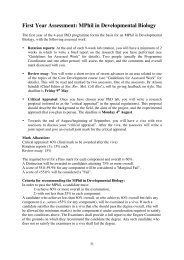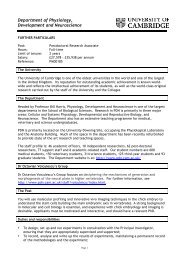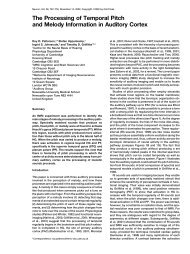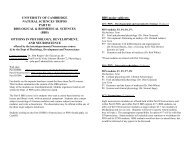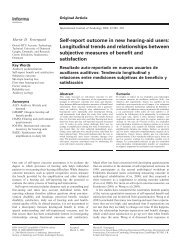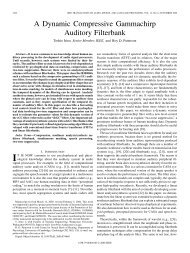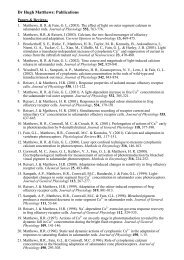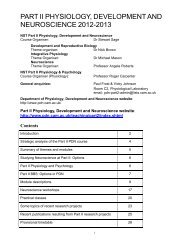FRIDAY MORNING, 20 MAY 2005 REGENCY E, 8:30 A.M. TO 12:00 ...
FRIDAY MORNING, 20 MAY 2005 REGENCY E, 8:30 A.M. TO 12:00 ...
FRIDAY MORNING, 20 MAY 2005 REGENCY E, 8:30 A.M. TO 12:00 ...
You also want an ePaper? Increase the reach of your titles
YUMPU automatically turns print PDFs into web optimized ePapers that Google loves.
9:55<br />
5aMU5. Normal modes of a single mandolin with different bracing patterns installed. David J. Cohen Cohen Musical<br />
Instruments, 9402 Belfort Rd., Richmond, VA 23229 and Thomas D. Rossing Northern Illinois Univ., DeKalb, IL 60115<br />
The vibrational modes and sound spectra of a single archtop mandolin constructed with a removable back plate were studied with<br />
different bracing patterns installed. The bracing patterns were i symmetric and ii asymmetric parallel ‘‘tone bars,’’ iii X-bracing,<br />
and iv an asymmetric pattern previously used and studied D. Cohen and T. D. Rossing, Can. Aeronautics Space, J. 42, 48–54<br />
<strong>20</strong><strong>00</strong>, D. Cohen and T. D. Rossing, Acoust. Sci. Tech. 24, 1–6 <strong>20</strong>03. The results have been compared with those obtained<br />
previously for vintage mandolins D. Cohen and T. D. Rossing, ‘‘Normal modes of different types of pre-1929 mandolins,’’ presented<br />
at the 147th meeting of the Acoustical Society of America, New York, NY <strong>20</strong>04 and for mandolins constructed more recently. As<br />
was the case for the different types of vintage mandolins, changing the bracing pattern has little effect on the shapes of the normal<br />
modes, but does affect the frequencies of the normal modes. The X- or crossed bracing pattern imparts more cross-grain stiffness than<br />
the other bracing patterns, with the result that modes involving cross-grain bending occur at higher frequencies than is the case for the<br />
other bracing patterns.<br />
10:<strong>20</strong>–10:<strong>30</strong> Break<br />
10:<strong>30</strong><br />
5aMU6. Design aspects of the five string banjo. James Rae Dept. Physio. and Biomed. Eng., Mayo Clinic College of Medicine,<br />
<strong>20</strong>0 First St. SW, Rochester, MN 55905, rae.james@mayo.edu and Thomas Rossing Northern Illinois Univ., DeKalb, IL 60115<br />
The five string banjo is a stringed instrument that uses a drum head membrane to radiate sound. The strings couple to the head<br />
through a moveable bridge. Many have a removable resonator whose spacing from the main part of the banjo is adjustable to allow<br />
tuning of the internal air cavity. Holographic interferometry demonstrates vibrational modes of the head that have a strong dependence<br />
on head tension. Driving point accelerance measurements demonstrate that the ability of the bridge to be vibrated depends on the mass<br />
and stiffness of the materials used in its construction. Peak accelerances usually occur between 18<strong>00</strong>–<strong>20</strong><strong>00</strong> Hz. Power spectra<br />
measurements of the sound show that 99% of the sound is in a frequency range of 147–5<strong>20</strong>0 Hz. Two substantial formants are seen<br />
in the power spectra. The first and largest occurs in about the 4<strong>00</strong>–18<strong>00</strong> Hz range, the same frequency range where the most<br />
substantial head modes are found. The second is from <strong>20</strong><strong>00</strong>–4<strong>00</strong>0 Hz, a range where the series combination of bridge and head show<br />
increasing accelerances by driving point measurements. Measurements of the transient response following a pluck quantify the<br />
frequency content of the rising and falling phase.<br />
10:55<br />
5aMU7. Tuning the lower resonances of carved Baltic psalteries by adjusting the areas of the sound holes. Andres Peekna<br />
Innovative Mech., Inc., 5908 N River Bay Rd., Waterford, WI 53185 and Thomas D. Rossing Northern Illinois Univ., De Kalb, IL<br />
60115<br />
Previous work has shown that with carved Baltic psalteries it is highly desirable to have a body-resonance with high radiating<br />
efficiency between the keynote and the tone above. In many cases, it is also desirable to have a body-resonance close to the low<br />
dominant. The frequencies of the two lowest body-resonances can be adjusted, to some extent, by adjusting the areas of the sound<br />
holes. We describe two trials. In one case, the instrument started out with no sound holes, and their areas were increased step by step,<br />
mostly according to listening trials, but the results were also verified by electronic TV holography. In the second case, the instrument<br />
started with excessive sound hole area. In this case, the listening tests first determined the extent of sound holes to be covered by<br />
sufficiently stiff material. The findings were subsequently confirmed by electronic TV holography. In both cases, a point was reached<br />
below which smaller areas the sound quality became less bright and more dull, and above which the sound quality was perceived as<br />
good. In each case, an optimum was reached.<br />
11:<strong>20</strong><br />
5aMU8. Harp design and construction. Chris Waltham Dept. of Phys. & Astron., Univ. of British Columbia, Vancouver, BC,<br />
Canada V6T 1Z1, waltham@physics.ubc.ca<br />
The harp is an instrument with a set of plucked strings connected directly to the sound board. Thus the requirement that the sound<br />
board be very light for efficient radiation is pitted against the requirement that the strings be tight enough to maintain harmonicity.<br />
These factors have determined the evolution of the harp since Sumerian times. As materials and construction methods have improved,<br />
strings have become tighter and sound boards lighter. Large harps have total tensions in the range of ten kilonewtons. The material of<br />
choice for the sound board, usually spruce, is pushed to the limits of its strength, and even professionally built concert harps tend not<br />
to last more than a few decades. The strings themselves are made from a variety of materials, wrapped or plain, to balance the physical<br />
requirements of tension and feel, with the acoustical demands of harmonicity and tone. Historical materials such as copper and silk<br />
have given way to steel and nylon, although gut still has a niche in the mid-range of a concert harp. These physics and engineering<br />
issues will be considered in the context of practical harp construction.<br />
2590 J. Acoust. Soc. Am., Vol. 117, No. 4, Pt. 2, April <strong>20</strong>05 149th Meeting: Acoustical Society of America 2590



